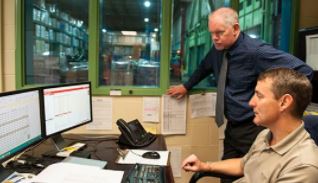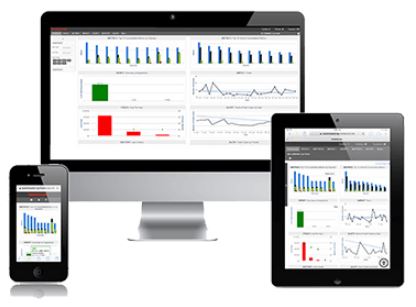Like nothing else out there, data gives you what you need to manage and optimize your business:
- Data can confirm something you think may be impacting your bottom line.
- Data can reveal information about your daily pain points and how to relieve them.
- Data can help you run your warehouse more cost-effectively, find production and performance issues, and see where you have incremental opportunities.
Let me tell you a little bit about the benefits of collecting data on your equipment using telematics.
Telematics monitors equipment like your lift truck fleet by using onboard GPS and accessing the incredibly rich data captured by the computer in your lift trucks. It will report on each operator on each truck to tell you how much time was spent actually working, spent lifting, traveling, idling and overall utilization. This data can then be used to help you improve your warehouse operations to benchmark, right size your fleet, and to improve productivity and efficiency.
incredibly rich data captured by the computer in your lift trucks. It will report on each operator on each truck to tell you how much time was spent actually working, spent lifting, traveling, idling and overall utilization. This data can then be used to help you improve your warehouse operations to benchmark, right size your fleet, and to improve productivity and efficiency.
Top three ways telematics can impact your daily operations:
OSHA-Required Record Keeping can be a nightmare if you’re still using a pen, paper, and clipboard. And, if you have fewer than five trucks in your fleet, it may seem that telematics isn’t necessary until you get one visit from OSHA. You don’t have an option when it comes to meeting compliance requirements, but wouldn’t it be easier to have all that data so you can easily access it 24/7? You’ll know that safe, proper operation of the truck is happening and, any time an OSHA inspector needs to verify that information, it can be as simple as sending them a real-time email of up-to-the-minute data from the lift truck.
Access Control requires that an operator swipe his or her key card to start up the equipment. This secure vehicle access means that only certified operators can run a lift truck type and they are logged in for every time stamp, start, stop, lift and mile. And that data can tell you if the equipment is being used efficiently and effectively in addition to the basic numbers of who, when and how. Telematics systems can also integrate a mix of vehicles from different manufacturers or in multiple warehouses to run smoother so you can manage smarter.
Impact Management allows you to increase user accountability and decrease damage. If an  employee runs into something, the telematics system in your forklift will send a text or email to you within moments, alerting management of impacts severe enough they should know about them. The system will also slow down the truck in the event of a severe impact but holds the data about the accident until a manager or supervisor can address it. This incredibly valuable impact sensor can help you determine when you need to reorganize aisles, acquire different equipment, or identify where more training may be necessary for your operators. And, because users know they are being monitored whenever they use a truck with telematics, some warehouses have seen incidents of damage go down by 50%.
employee runs into something, the telematics system in your forklift will send a text or email to you within moments, alerting management of impacts severe enough they should know about them. The system will also slow down the truck in the event of a severe impact but holds the data about the accident until a manager or supervisor can address it. This incredibly valuable impact sensor can help you determine when you need to reorganize aisles, acquire different equipment, or identify where more training may be necessary for your operators. And, because users know they are being monitored whenever they use a truck with telematics, some warehouses have seen incidents of damage go down by 50%.
Why Telematics?
This is tomorrow’s technology- today. Telematics can help you to increase the overall efficiency of your warehouse while reducing operational costs. It can be scaled to fit your needs and is flexible enough to work with warehouses of practically any size. Telematics also can help you simplify asset management and maintenance, right-size your fleet, and determine exactly what equipment you need. What’s your real cost per hour on a particular piece of equipment? Do the utilization metrics indicate you have too many forklifts – or too few, or the wrong mix?
Are your forklifts always running out of battery life meaning you have to shuffle labor as a result? Telematics systems also can send you an email or text alerts about battery temperature, water levels, charge intervals and charge levels.
Data from your fleet can be configured any way you need it to be delivered. For instance, Raymond’s iWarehouse can be accessed from any web-enabled device, anywhere, anytime. Simply choose the capabilities you want, and an easy-to-use interface puts operator and fleet data at your fingertips for smarter, faster decision-making. And if managing all that data feels overwhelming, some systems offer expert services to break it all down for you.
All forklifts go up and down. Telematics help you keep an eye on the bottom line to make sure productivity, efficiency and proficiency all keep going up.



Leave a Reply
You must be logged in to post a comment.